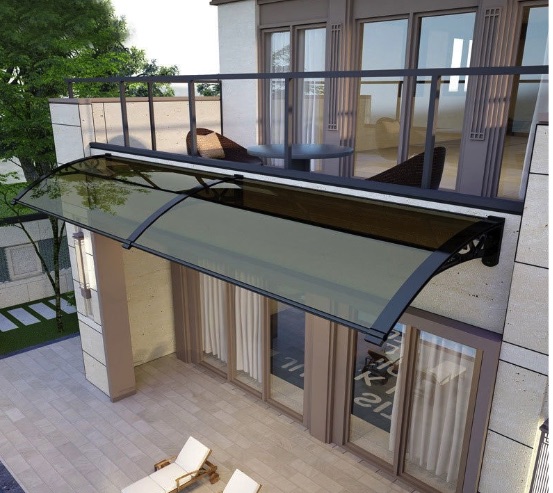
When buying an awning, it’s important to consider several factors to make sure you choose the right one that meets your specific needs. Awnings not only protect from the heat but also increase the look of your property. We will discuss key factors to consider when purchasing an awning.
- Purpose and Function: Before buying an awning, determine its intended purpose and function. Are you looking for shade on a patio or deck? Do you want to protect windows from excessive sunlight? Are you aiming to extend your outdoor living space or create a designated area for customers at a business? Clarifying your requirements will help you choose the right type, size, and design for the awning.
- Awning Type: There are several types of awnings available, each with its advantages and characteristics. Some common types include:
- Retractable Awnings: These awnings are adjustable and can be extended or retracted as needed. They offer flexibility in controlling the sunlight you get. The cost of retractable awnings ranges from $500 to $4,000 or more. The price depends on the size, quality of materials, manual or motorized operation, and additional features such as wind or sun sensors.
- Fixed Awnings: These awnings are permanently installed and suitable for areas where constant shade is desired. The cost of fixed awnings can range from $200 to $1,500 or more. The price depends on the size, materials used (such as fabric or metal), design complexity, and installation requirements.
- Freestanding Awnings: These awnings are independent structures that can be placed anywhere, providing versatile shade and protection. The cost of freestanding awnings varies widely depending on the size, materials, design, and features.
- Size and Coverage: Measure the width, height, and projection (distance from the mounting point to the furthest point the awning extends). Ensure the awning provides adequate coverage for your intended use, whether it’s shading a patio, covering windows, or creating a designated outdoor space. Consider the orientation of the sun and how it will impact the coverage provided by the awning throughout the day.
- Material and Durability: Awnings are available in various materials with benefits and durability. Common materials include:
- Fabric: Fabric awnings offer versatility, as they are available in different colors, patterns, and textures. Look for fabrics that are fade-resistant, water-repellent, and resistant to mildew or mold growth. Quality fabrics, such as acrylic or polyester blends, are known for their longevity.
- Metal: Metal awnings, such as aluminum or steel, provide excellent durability and strength. They are resistant to rust and can handle bad weather. Metal awnings are often chosen for commercial applications due to their sturdiness.
- Aluminum: Aluminum awnings are known for their durability and strength. They are made from lightweight, rust-resistant aluminum panels.
- Vinyl awnings are lightweight, affordable, and low-maintenance options. They are typically made from PVC (polyvinyl chloride) material.
- Wood awnings provide a natural, traditional look and are commonly used in residential applications.
- Frame and Structure: The frame and structure of the awning play a vital role in its stability and durability. Look for a robust frame made of high-quality materials, such as aluminum or steel, which offer strength and resistance to corrosion. The joints and connections should be well-constructed and reinforced to withstand wind and other environmental factors. Inspect the overall build quality of the awning to ensure it will provide long-lasting performance.
- Ease of Operation: If you choose a retractable awning, consider the ease of operation. Look for features such as motorized or manual controls that allow for effortless extension and retraction. Motorized options often offer convenience, allowing you to control the awning with a remote or a wall switch. Some advanced models even have wind sensors or sun sensors that automatically adjust the awning based on weather conditions.
- Aesthetic: Awnings can significantly increase the appearance of your property. You need to consider the design, color, and style of the awning to match your building. You can use customization options, such as different fabric patterns or designs, that allow you to personalize the awning to match your preferences.
- Warranty and Maintenance: Check the warranty provided by the manufacturer or retailer. A reliable warranty indicates the confidence of the manufacturer in the product’s quality. Additionally, inquire about the maintenance requirements of the awning. Some materials may require occasional cleaning or fabric treatment to maintain their appearance and performance. Don’t forget to do long-term maintenance, to ensure the awning remains in good condition.
- Budget: Establish a budget for your awning purchase. Awnings have various price points, depending on various factors such as size, material, features, and customization options. Determine your budget in advance and prioritize your requirements to make a decision that fits within your financial constraints. You can also add the cost of installation and customization to your budget.
- Contractor: When buying an awning, you need to select a good contractor. Start by researching different awning contractors in your area. Look for their websites, portfolios, customer reviews, and ratings. Check if they have experience with the type of awning you need and if they offer the specific services you require. It’s crucial to work with a contractor who is properly licensed and insured. Ask for their license number and verify it with the appropriate licensing authority. Additionally, ensure they have liability insurance and workers’ compensation coverage to protect yourself from any potential liabilities.
